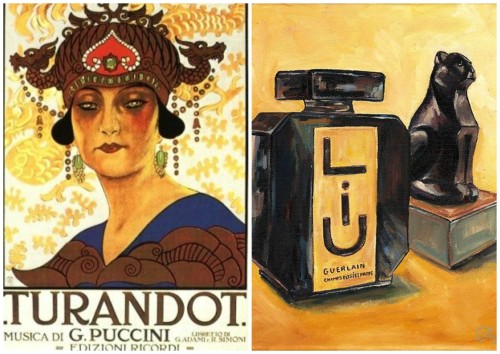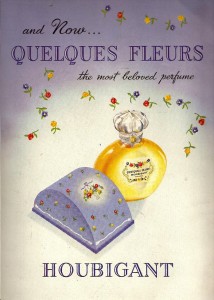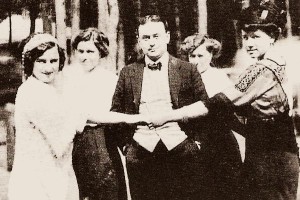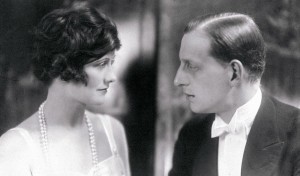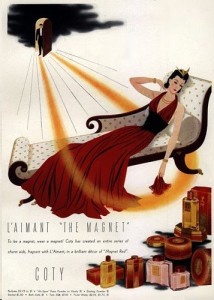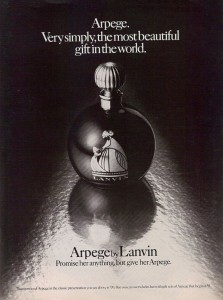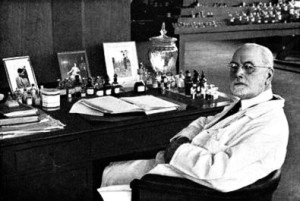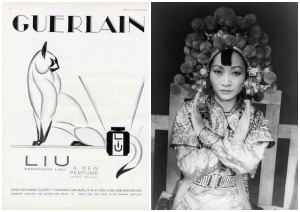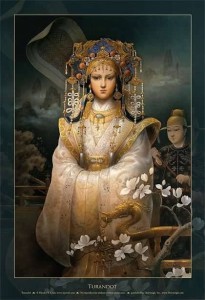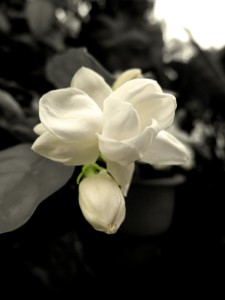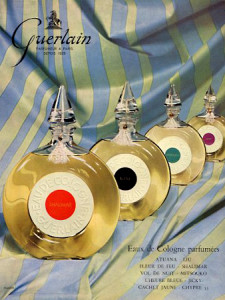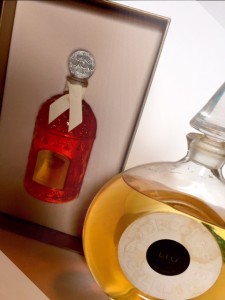1929 Poster for Puccini's Turandot and oil painting Liu guerlain Bacarrat perfume bottles by Cecely Bloom
Liù, the name in itself causes me to wonder what glorious things the perfume bottle holds. It’s as historical as it is still relevant. Created by Jacques Guerlain from inspiration taken from Puccini’s Turandot, it’s a perfume that truly encapsulates what I call “history in a bottle” in more ways than just one. Moreover, it’s a shining example of the history making genre/group/category known as, the Floral Aldehyde.
Houbigant Quelques Fleur launched in 1912 and ushered in the age of BIG floral Aldehydes
I have heard it said time and time again that Liù is a direct relative of Chanel’s No. 5. However true that maybe, it goes much deeper than being a copycat of the Chanel (Ernest Beaux) behemoth. Fact of the matter is, a great many perfumes of the era where influenced by the ground breaking work of Robert Bienaimé with Houbigant’s Quelques Fleurs. Quelques Fleurs was a revelation to the perfume industry at the time of its launch in 1912. Its use of aldehydes was unrivaled and, as such, it was highly regarded amongst the upper echelon of society. Of course, this did not go unnoticed by perfume manufactures and the desire to one up it began soon after its introduction. In my opinion, the creation of this perfume, and ultimately genre, caused a massive shift in the industry to commercialism and the rise of rivalrous competition between fashion houses and the great perfumeries of the time. Simply put, everyone wanted a piece of the ever growing profitability of a product that the masses could enjoy. So, what exactly did it do?
Russian Perfumer Ernest Beaux (1920) The Godfather of Aldehydes
Among the first to take the composition on was Russian perfumer Ernest Beaux with the creation of 1913’s Bouquet de Catherine (later renamed Rallet No. 1) for A. Rallet & Co. in Russia. Unfortunately, for Rallet and Beaux, the perfume was not a large success. The turmoil that led to WWI (1914-1918) up to and including the Russian Revolution (1917) helped squash its need and appeal for many. In fact, Rallet, along with most every Russian industry, was nationalized during the revolution; further destroying any hopes, and essentially halting everything prior. Beaux himself (being of French heritage) served in the French military during WWI – halting his ability to work. With situations being as they were, the decade passed and there were still relatively few contenders to Houbigant’s innovation. That changed when Beaux was released from service in 1919. Unable to return to Russia, he settled in Paris to continue his perfumery work. Over a period of a year he took his previous ideas and improved upon them. He had a goal of infusing the cold freshness he experienced in the far Northern landscapes during the war into fragrance. His experiments proved pivotal as his earlier work of Bouquet de Catherine was infused with the new idea. This, along with other experiments in this style expounded upon the aldehyde laden works that would follow.
Gabrielle Chanel met Ernest Beaux through her lover the Grand Duke Dmitri Pavlovitch
In 1920 his new work was presented to Mademoiselle Chanel after she chose him to make a perfume that would best represent her style. He presented her with a little set of samples (containing variants numbered 1-5 and 20-24) and asked her to choose her favorite. Her number one choice was vial number 5, and it became just that, No. 5. With a nearly mystical fervor, she went ahead with introducing No. 5 in a manner that was largely unseen in the scope of the industry to that time. As it turned out, it was an event paramount to a changing environment in both art and industry. Over the next few years No. 5 became the standard to which all others would be compared…despite not being the first of the genre.
Coty L'Aimant "The Magnet" Vincent Roubert 1927
By the end of the 1920’s large fashion and perfume houses took note. In 1927 Coty released L’Aimant by Vincent Roubert which was a huge success and very, very similar to No.5. Lanvin released its successful rendition on the theme, Arpège by André Fraysse that same year.
Arpège was created in 1927 by André Fraysse
Not wanting to be outdone, 1928 saw Houbigant attempt to top itself with the wonderful Robert Bienaimé classic, Essence Rare. At the turn of the decade others followed suite: Jean Patou with Joy by Henri Alméras; Worth with Je Reviens by Maurice Blanchet; and Caron with Ernest Daltroff’s Fleurs de Rocaille. With all the releases coming out steadily, one thing was abundantly clear- the Floral Aldehyde was here to stay…and stay it did.
Jaques Guerlain (courtesy of Guerlain)
Guerlain, of course, was not oblivious to the phenomenon. In 1929 Guerlain offered to the world, Liù by Jacques Guerlain. The actual story behind the creation of Liù is interesting and great for lovers of folklore. It’s been said that Jacques made the perfume out of a bit of jealousy for his wife wearing his rival’s creations (Coty’s L’Aimant and Chanel’s No. 5); therefore, its creation may have been much, much more than just to compete – it could have been a declaration of love with a smattering of smite! Touché!
1929 vintage ad of Guerlain and Carl Van Vechten portrait of Anna May Wong in her performance of Turandot
Whereas Chanel chose to keep the marketing and presentation of No. 5 very simple, Guerlain went all out. A feature of Liù is that it marries the genre with Orientalism beautify – a theme that Guerlain continued from the introduction of Shalimar. Everything from its packaging to story behind it the idea, the air of refined art and history is evident. To keep with the Oriental theme, the packaging for Liù was influenced by Chinese tea (and possibly music) boxes infused with Art Deco elements popular at the time – making for a striking presentation as compared to Chanel’s simplicity. When fused with the inspiration of Turandot, the story is woven into something wholly different, and expressly Guerlain was born.
Turandot by Kinuko Y. Craft, jasmine
As has been surmised, the overall effect of Liù is quite similar to No. 5 in the beginning. However, there are key differences as the fragrance wears on. In my exploration of the differences I have noticed that Liù stays closer to the skin than No. 5 and in the mid stages Jasmine is a bit more prominent. This may not be a coincidence as it plays very well into a theme in Turandot (and contains a clue regarding coldness that No. 5 was influenced by!) with part of the score, “Mo-Li-Hua” (Jasmine Flower). One translation of the song goes:
What a jasmine flower!
Of all the fragrant flowers and grasses in the garden, there is none as fragrant as it.
I want to pluck one and wear it, but the gardener would scold me.
What a jasmine flower!
When jasmine blooms, not even snow is whiter.
I want to pluck one and wear it, but I'm afraid those around me would mock me.
What a jasmine flower!
Of all the blooms in the garden, none compares to it.
I want to pluck one and wear it, but I'm afraid it wouldn't bud next year.
Vintage ad from 1956 by Guerlain: Shalimar, Liu, Mitsouko and Jicky.
The juxtaposition into the base notes further distances Liù from No. 5. In the mid stages the “waxy” effect of No. 5 is much, much less evident (if not altogether absent) in Liù. This stage is much more floral and woody in nature with the attention turning to a more woody vanilla (vaguely along the lines of a muted Chanel No. 22) and a powdery iris more associated with Guerlain. This begs the question… Is it Guerlinade? No, not really, but the hint is certainly there!
Aaron's collection of Liù (watch shape bottle) and Les Parisiennes
Although Liù was discontinued a number of years ago, it was reintroduced for a short time in the 90’s and then again discontinued. Formulations up to that point were generally EDT. It also existed as a parfum (which was rumored to be created for Rose Kennedy). There was an EDC released in the “watch shaped” bottle, but this version seems to be difficult to track down. I am fortunate in having a bottle that I picked up for nearly nothing at a flea market – yes, I treasure it! Currently the fragrance is available in the Parisiennes collection as an EDP.
I am happy to say that all versions are very similar with negligible difference between any of the formulations. Does it warranty going crazy trying to find vintage? No, not unless you are a bottle collector. Unless, of course, you get a really good deal on it or are lucky enough to find it for sale from someone not in the know! That said, vintage Liù does pop up on EBay and other auction sites now and again with prices that sometime rival the cost of a new bottle.
-Aaron Potterman, Vintage Perfume Columnist and perfumer for Maison303
Art Direction: Michelyn
We have a 2ml vial of Guerlain Liù (we believe is from early 1970s) for a US registered reader. To be eligible please leave a comment with what intrigues you about the history of Liù, what you learned from Aaron’s review, and your favorite vintage Guerlain Perfume. Draw closes 8/31/2015

